Contracts and Procurement Case Study: Project Management Essentials
VerifiedAdded on 2022/11/23
|13
|2777
|167
Case Study
AI Summary
This case study centers on a project involving the supply and installation of a gearbox, where a Request for Proposal (RFP) was issued to multiple suppliers. The core issue revolves around negotiating contract terms with a selected supplier, as they disagreed with the initially proposed conditions. The assignment analyzes the steps required to review, negotiate, and resolve the rejected terms, including the configuration control of documents. It assesses contractual risks associated with accepting the supplier's changes, explores alternative negotiation strategies, and examines the impact of prolonged negotiations on project schedules. Furthermore, it evaluates the benefits of a 'cost neutral' approach to project costs and the risks associated with an unbalanced milestone payment schedule. The case study covers key issues like contract terms, rejected conditions, risk assessment, negotiation strategies, and the impact of prolonged negotiations on project schedules and budgets, providing insights into effective contract management and procurement practices.
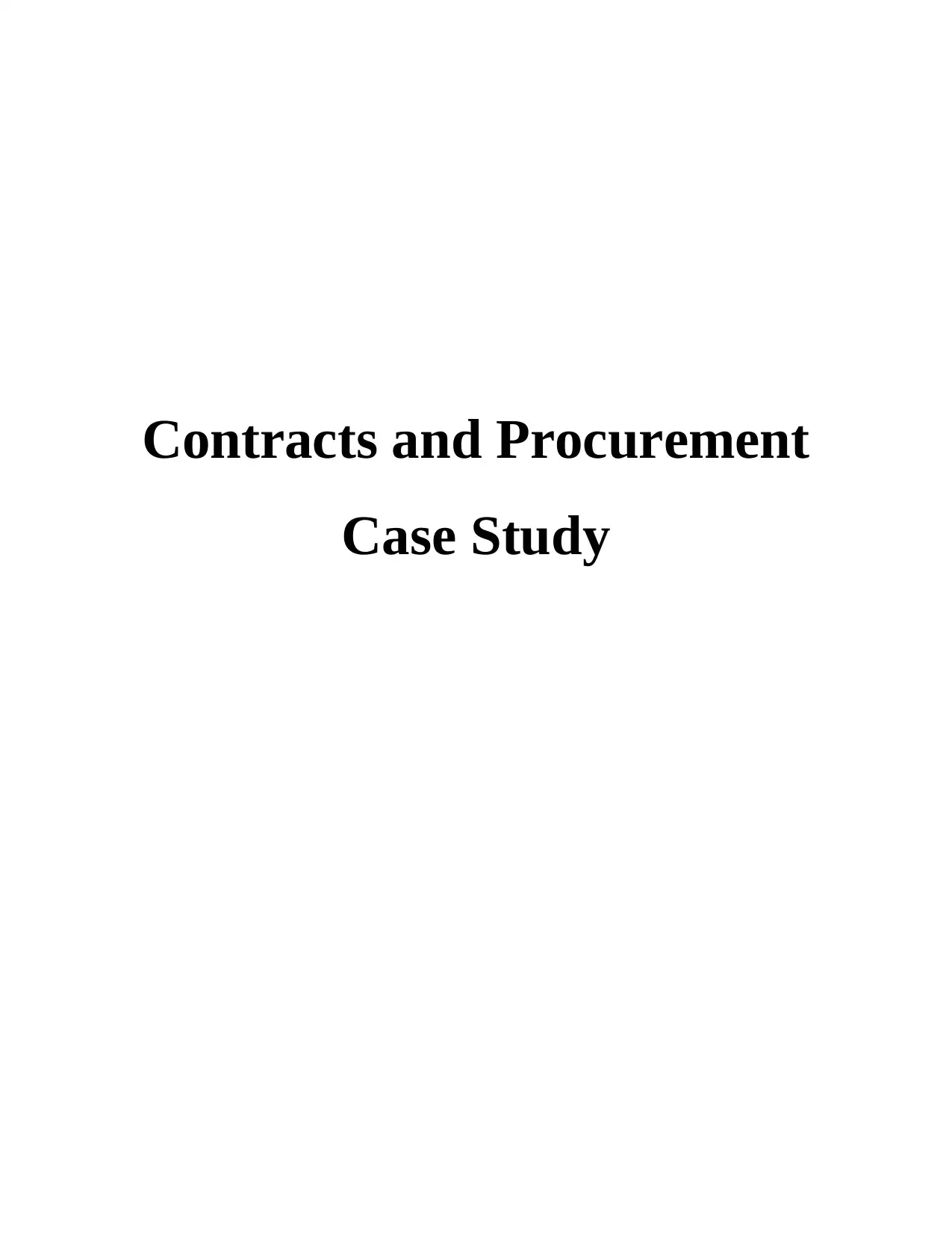
Contracts and Procurement
Case Study
Case Study
Paraphrase This Document
Need a fresh take? Get an instant paraphrase of this document with our AI Paraphraser

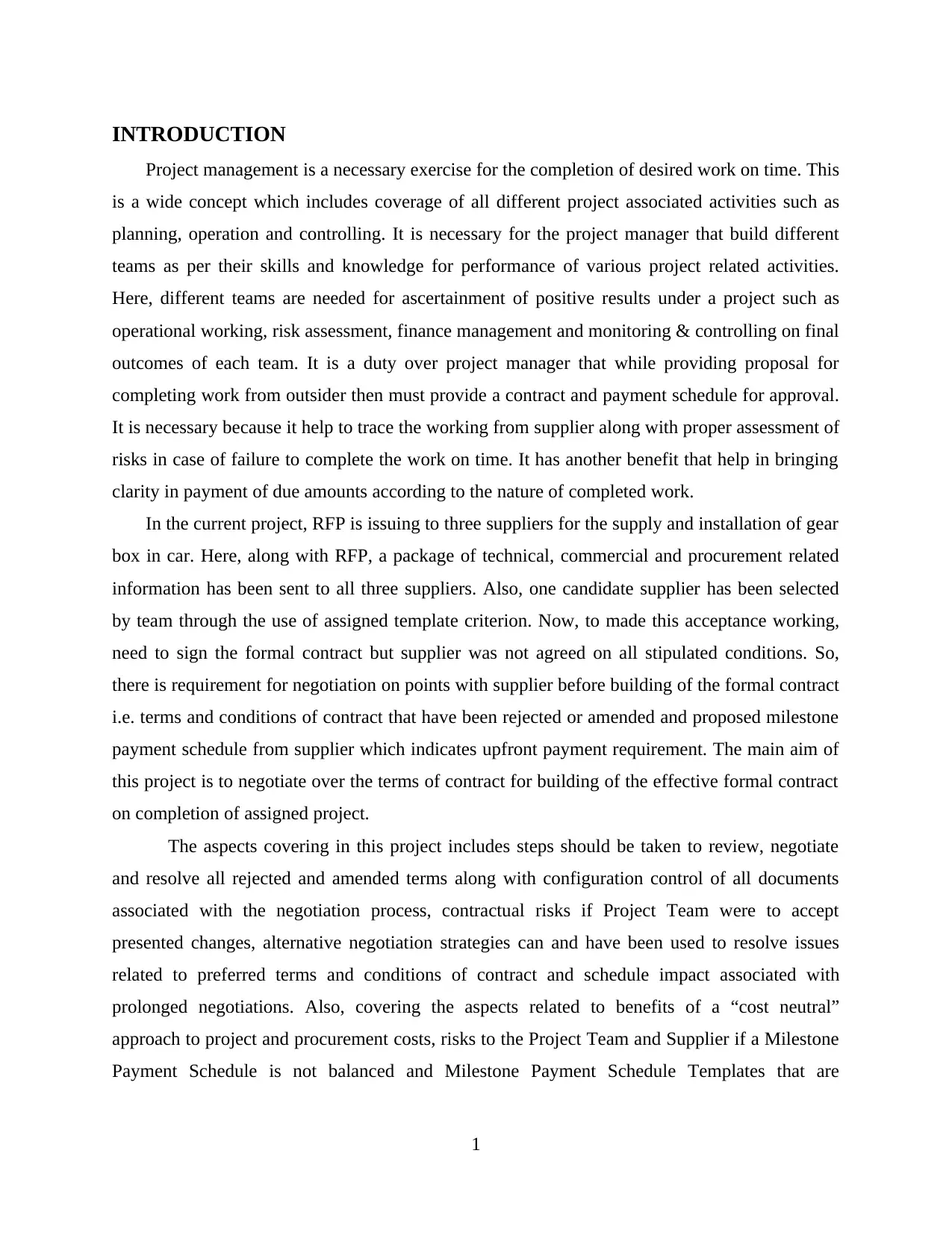
INTRODUCTION
Project management is a necessary exercise for the completion of desired work on time. This
is a wide concept which includes coverage of all different project associated activities such as
planning, operation and controlling. It is necessary for the project manager that build different
teams as per their skills and knowledge for performance of various project related activities.
Here, different teams are needed for ascertainment of positive results under a project such as
operational working, risk assessment, finance management and monitoring & controlling on final
outcomes of each team. It is a duty over project manager that while providing proposal for
completing work from outsider then must provide a contract and payment schedule for approval.
It is necessary because it help to trace the working from supplier along with proper assessment of
risks in case of failure to complete the work on time. It has another benefit that help in bringing
clarity in payment of due amounts according to the nature of completed work.
In the current project, RFP is issuing to three suppliers for the supply and installation of gear
box in car. Here, along with RFP, a package of technical, commercial and procurement related
information has been sent to all three suppliers. Also, one candidate supplier has been selected
by team through the use of assigned template criterion. Now, to made this acceptance working,
need to sign the formal contract but supplier was not agreed on all stipulated conditions. So,
there is requirement for negotiation on points with supplier before building of the formal contract
i.e. terms and conditions of contract that have been rejected or amended and proposed milestone
payment schedule from supplier which indicates upfront payment requirement. The main aim of
this project is to negotiate over the terms of contract for building of the effective formal contract
on completion of assigned project.
The aspects covering in this project includes steps should be taken to review, negotiate
and resolve all rejected and amended terms along with configuration control of all documents
associated with the negotiation process, contractual risks if Project Team were to accept
presented changes, alternative negotiation strategies can and have been used to resolve issues
related to preferred terms and conditions of contract and schedule impact associated with
prolonged negotiations. Also, covering the aspects related to benefits of a “cost neutral”
approach to project and procurement costs, risks to the Project Team and Supplier if a Milestone
Payment Schedule is not balanced and Milestone Payment Schedule Templates that are
1
Project management is a necessary exercise for the completion of desired work on time. This
is a wide concept which includes coverage of all different project associated activities such as
planning, operation and controlling. It is necessary for the project manager that build different
teams as per their skills and knowledge for performance of various project related activities.
Here, different teams are needed for ascertainment of positive results under a project such as
operational working, risk assessment, finance management and monitoring & controlling on final
outcomes of each team. It is a duty over project manager that while providing proposal for
completing work from outsider then must provide a contract and payment schedule for approval.
It is necessary because it help to trace the working from supplier along with proper assessment of
risks in case of failure to complete the work on time. It has another benefit that help in bringing
clarity in payment of due amounts according to the nature of completed work.
In the current project, RFP is issuing to three suppliers for the supply and installation of gear
box in car. Here, along with RFP, a package of technical, commercial and procurement related
information has been sent to all three suppliers. Also, one candidate supplier has been selected
by team through the use of assigned template criterion. Now, to made this acceptance working,
need to sign the formal contract but supplier was not agreed on all stipulated conditions. So,
there is requirement for negotiation on points with supplier before building of the formal contract
i.e. terms and conditions of contract that have been rejected or amended and proposed milestone
payment schedule from supplier which indicates upfront payment requirement. The main aim of
this project is to negotiate over the terms of contract for building of the effective formal contract
on completion of assigned project.
The aspects covering in this project includes steps should be taken to review, negotiate
and resolve all rejected and amended terms along with configuration control of all documents
associated with the negotiation process, contractual risks if Project Team were to accept
presented changes, alternative negotiation strategies can and have been used to resolve issues
related to preferred terms and conditions of contract and schedule impact associated with
prolonged negotiations. Also, covering the aspects related to benefits of a “cost neutral”
approach to project and procurement costs, risks to the Project Team and Supplier if a Milestone
Payment Schedule is not balanced and Milestone Payment Schedule Templates that are
1
⊘ This is a preview!⊘
Do you want full access?
Subscribe today to unlock all pages.

Trusted by 1+ million students worldwide
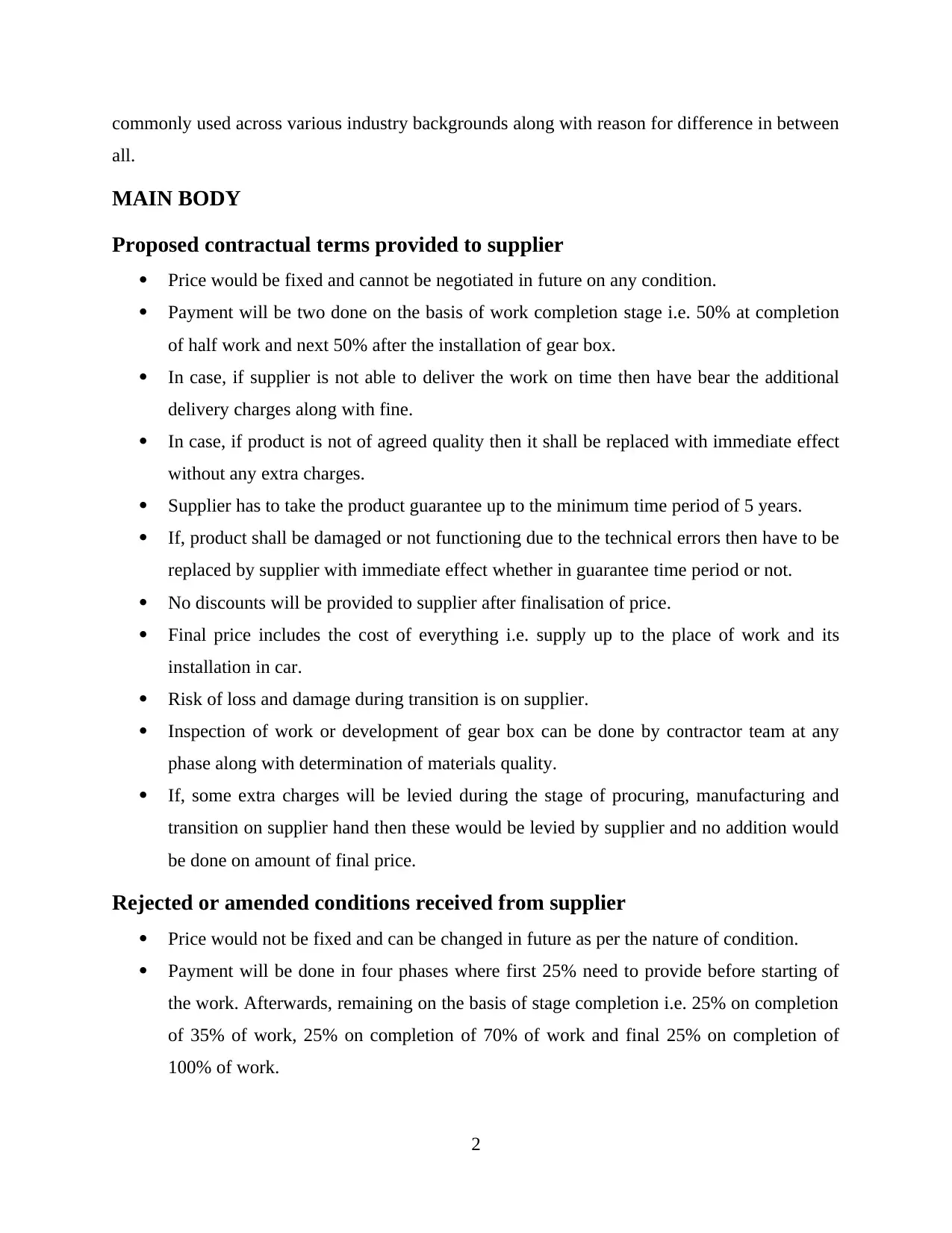
commonly used across various industry backgrounds along with reason for difference in between
all.
MAIN BODY
Proposed contractual terms provided to supplier
Price would be fixed and cannot be negotiated in future on any condition.
Payment will be two done on the basis of work completion stage i.e. 50% at completion
of half work and next 50% after the installation of gear box.
In case, if supplier is not able to deliver the work on time then have bear the additional
delivery charges along with fine.
In case, if product is not of agreed quality then it shall be replaced with immediate effect
without any extra charges.
Supplier has to take the product guarantee up to the minimum time period of 5 years.
If, product shall be damaged or not functioning due to the technical errors then have to be
replaced by supplier with immediate effect whether in guarantee time period or not.
No discounts will be provided to supplier after finalisation of price.
Final price includes the cost of everything i.e. supply up to the place of work and its
installation in car.
Risk of loss and damage during transition is on supplier.
Inspection of work or development of gear box can be done by contractor team at any
phase along with determination of materials quality.
If, some extra charges will be levied during the stage of procuring, manufacturing and
transition on supplier hand then these would be levied by supplier and no addition would
be done on amount of final price.
Rejected or amended conditions received from supplier
Price would not be fixed and can be changed in future as per the nature of condition.
Payment will be done in four phases where first 25% need to provide before starting of
the work. Afterwards, remaining on the basis of stage completion i.e. 25% on completion
of 35% of work, 25% on completion of 70% of work and final 25% on completion of
100% of work.
2
all.
MAIN BODY
Proposed contractual terms provided to supplier
Price would be fixed and cannot be negotiated in future on any condition.
Payment will be two done on the basis of work completion stage i.e. 50% at completion
of half work and next 50% after the installation of gear box.
In case, if supplier is not able to deliver the work on time then have bear the additional
delivery charges along with fine.
In case, if product is not of agreed quality then it shall be replaced with immediate effect
without any extra charges.
Supplier has to take the product guarantee up to the minimum time period of 5 years.
If, product shall be damaged or not functioning due to the technical errors then have to be
replaced by supplier with immediate effect whether in guarantee time period or not.
No discounts will be provided to supplier after finalisation of price.
Final price includes the cost of everything i.e. supply up to the place of work and its
installation in car.
Risk of loss and damage during transition is on supplier.
Inspection of work or development of gear box can be done by contractor team at any
phase along with determination of materials quality.
If, some extra charges will be levied during the stage of procuring, manufacturing and
transition on supplier hand then these would be levied by supplier and no addition would
be done on amount of final price.
Rejected or amended conditions received from supplier
Price would not be fixed and can be changed in future as per the nature of condition.
Payment will be done in four phases where first 25% need to provide before starting of
the work. Afterwards, remaining on the basis of stage completion i.e. 25% on completion
of 35% of work, 25% on completion of 70% of work and final 25% on completion of
100% of work.
2
Paraphrase This Document
Need a fresh take? Get an instant paraphrase of this document with our AI Paraphraser
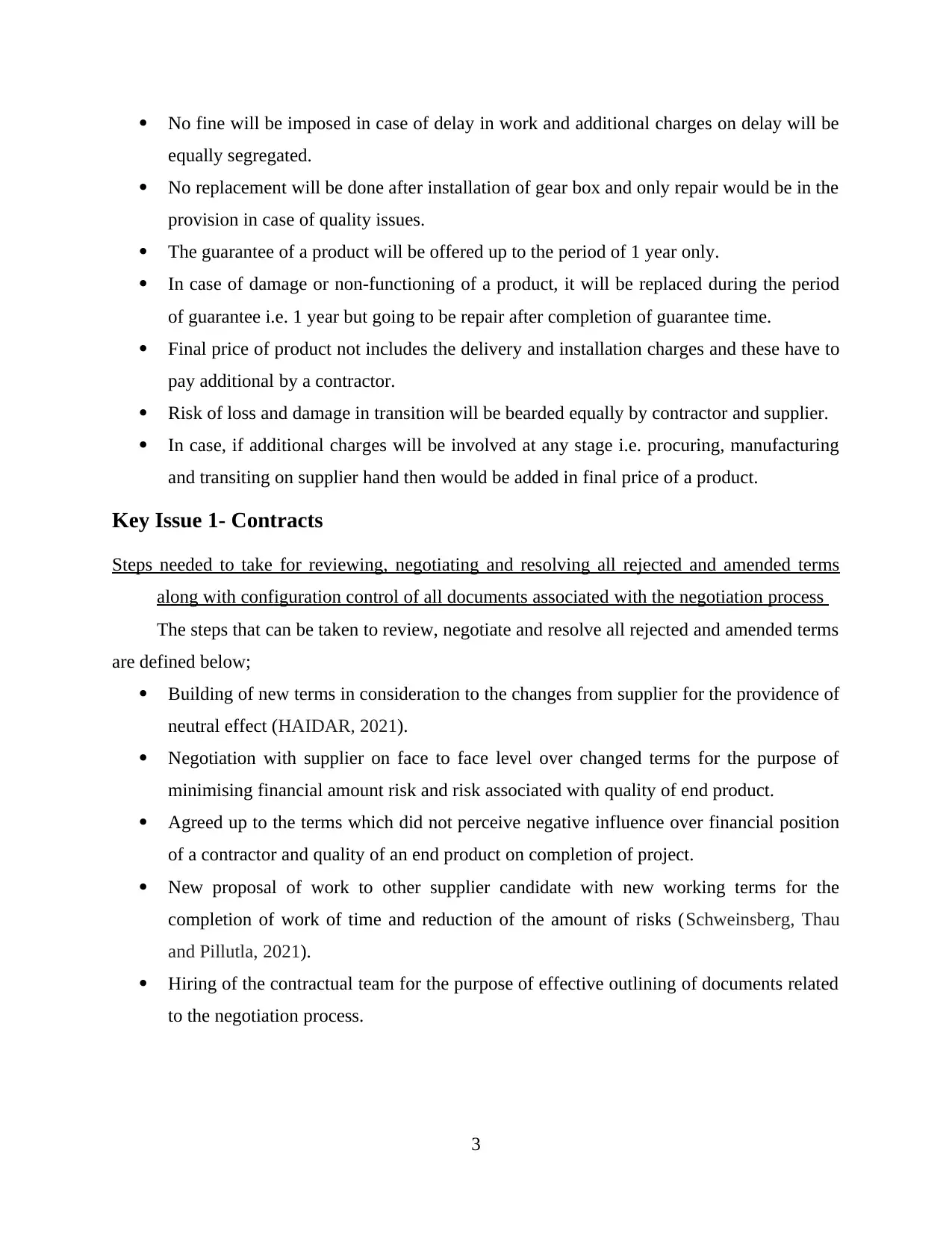
No fine will be imposed in case of delay in work and additional charges on delay will be
equally segregated.
No replacement will be done after installation of gear box and only repair would be in the
provision in case of quality issues.
The guarantee of a product will be offered up to the period of 1 year only.
In case of damage or non-functioning of a product, it will be replaced during the period
of guarantee i.e. 1 year but going to be repair after completion of guarantee time.
Final price of product not includes the delivery and installation charges and these have to
pay additional by a contractor.
Risk of loss and damage in transition will be bearded equally by contractor and supplier.
In case, if additional charges will be involved at any stage i.e. procuring, manufacturing
and transiting on supplier hand then would be added in final price of a product.
Key Issue 1- Contracts
Steps needed to take for reviewing, negotiating and resolving all rejected and amended terms
along with configuration control of all documents associated with the negotiation process
The steps that can be taken to review, negotiate and resolve all rejected and amended terms
are defined below;
Building of new terms in consideration to the changes from supplier for the providence of
neutral effect (HAIDAR, 2021).
Negotiation with supplier on face to face level over changed terms for the purpose of
minimising financial amount risk and risk associated with quality of end product.
Agreed up to the terms which did not perceive negative influence over financial position
of a contractor and quality of an end product on completion of project.
New proposal of work to other supplier candidate with new working terms for the
completion of work of time and reduction of the amount of risks (Schweinsberg, Thau
and Pillutla, 2021).
Hiring of the contractual team for the purpose of effective outlining of documents related
to the negotiation process.
3
equally segregated.
No replacement will be done after installation of gear box and only repair would be in the
provision in case of quality issues.
The guarantee of a product will be offered up to the period of 1 year only.
In case of damage or non-functioning of a product, it will be replaced during the period
of guarantee i.e. 1 year but going to be repair after completion of guarantee time.
Final price of product not includes the delivery and installation charges and these have to
pay additional by a contractor.
Risk of loss and damage in transition will be bearded equally by contractor and supplier.
In case, if additional charges will be involved at any stage i.e. procuring, manufacturing
and transiting on supplier hand then would be added in final price of a product.
Key Issue 1- Contracts
Steps needed to take for reviewing, negotiating and resolving all rejected and amended terms
along with configuration control of all documents associated with the negotiation process
The steps that can be taken to review, negotiate and resolve all rejected and amended terms
are defined below;
Building of new terms in consideration to the changes from supplier for the providence of
neutral effect (HAIDAR, 2021).
Negotiation with supplier on face to face level over changed terms for the purpose of
minimising financial amount risk and risk associated with quality of end product.
Agreed up to the terms which did not perceive negative influence over financial position
of a contractor and quality of an end product on completion of project.
New proposal of work to other supplier candidate with new working terms for the
completion of work of time and reduction of the amount of risks (Schweinsberg, Thau
and Pillutla, 2021).
Hiring of the contractual team for the purpose of effective outlining of documents related
to the negotiation process.
3
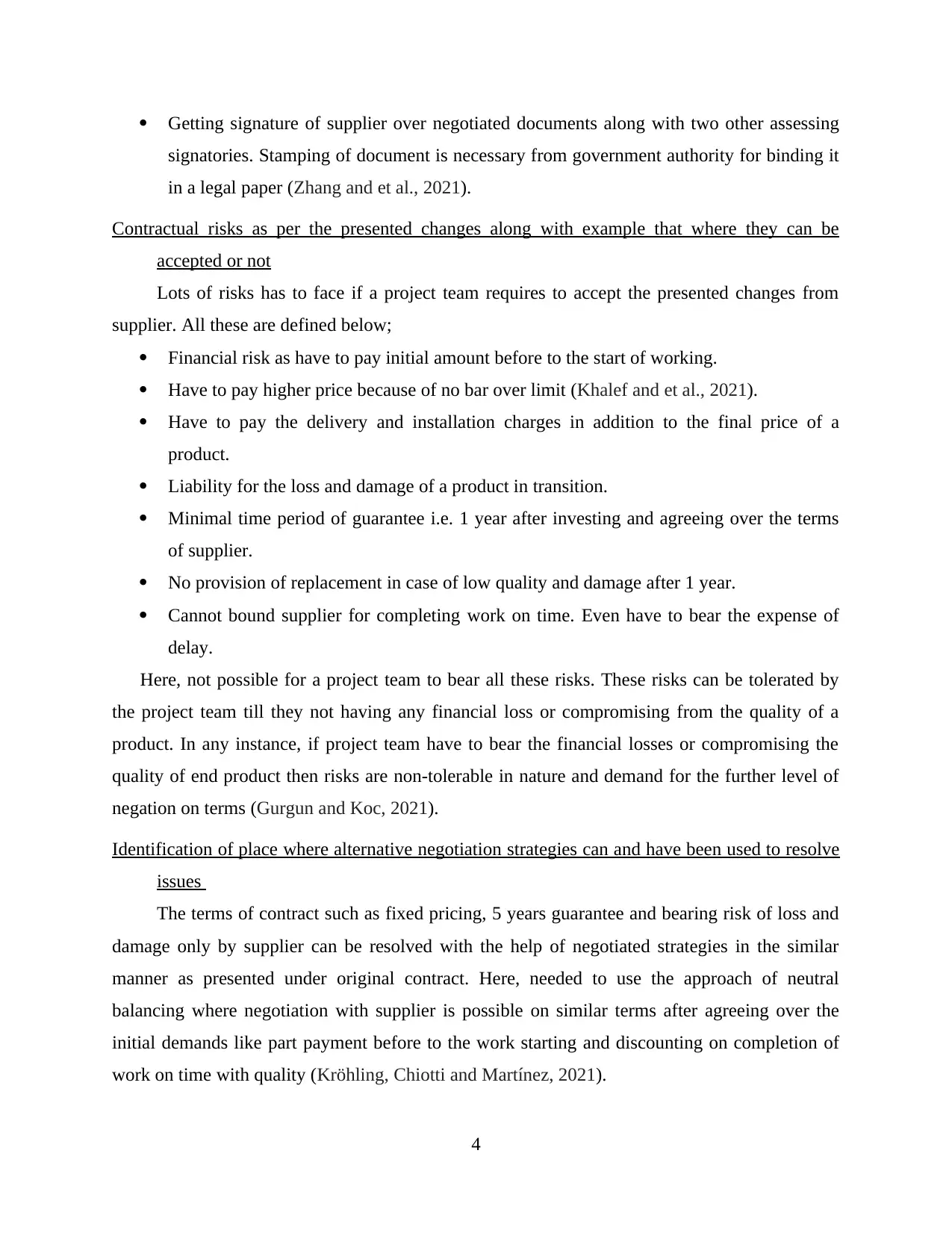
Getting signature of supplier over negotiated documents along with two other assessing
signatories. Stamping of document is necessary from government authority for binding it
in a legal paper (Zhang and et al., 2021).
Contractual risks as per the presented changes along with example that where they can be
accepted or not
Lots of risks has to face if a project team requires to accept the presented changes from
supplier. All these are defined below;
Financial risk as have to pay initial amount before to the start of working.
Have to pay higher price because of no bar over limit (Khalef and et al., 2021).
Have to pay the delivery and installation charges in addition to the final price of a
product.
Liability for the loss and damage of a product in transition.
Minimal time period of guarantee i.e. 1 year after investing and agreeing over the terms
of supplier.
No provision of replacement in case of low quality and damage after 1 year.
Cannot bound supplier for completing work on time. Even have to bear the expense of
delay.
Here, not possible for a project team to bear all these risks. These risks can be tolerated by
the project team till they not having any financial loss or compromising from the quality of a
product. In any instance, if project team have to bear the financial losses or compromising the
quality of end product then risks are non-tolerable in nature and demand for the further level of
negation on terms (Gurgun and Koc, 2021).
Identification of place where alternative negotiation strategies can and have been used to resolve
issues
The terms of contract such as fixed pricing, 5 years guarantee and bearing risk of loss and
damage only by supplier can be resolved with the help of negotiated strategies in the similar
manner as presented under original contract. Here, needed to use the approach of neutral
balancing where negotiation with supplier is possible on similar terms after agreeing over the
initial demands like part payment before to the work starting and discounting on completion of
work on time with quality (Kröhling, Chiotti and Martínez, 2021).
4
signatories. Stamping of document is necessary from government authority for binding it
in a legal paper (Zhang and et al., 2021).
Contractual risks as per the presented changes along with example that where they can be
accepted or not
Lots of risks has to face if a project team requires to accept the presented changes from
supplier. All these are defined below;
Financial risk as have to pay initial amount before to the start of working.
Have to pay higher price because of no bar over limit (Khalef and et al., 2021).
Have to pay the delivery and installation charges in addition to the final price of a
product.
Liability for the loss and damage of a product in transition.
Minimal time period of guarantee i.e. 1 year after investing and agreeing over the terms
of supplier.
No provision of replacement in case of low quality and damage after 1 year.
Cannot bound supplier for completing work on time. Even have to bear the expense of
delay.
Here, not possible for a project team to bear all these risks. These risks can be tolerated by
the project team till they not having any financial loss or compromising from the quality of a
product. In any instance, if project team have to bear the financial losses or compromising the
quality of end product then risks are non-tolerable in nature and demand for the further level of
negation on terms (Gurgun and Koc, 2021).
Identification of place where alternative negotiation strategies can and have been used to resolve
issues
The terms of contract such as fixed pricing, 5 years guarantee and bearing risk of loss and
damage only by supplier can be resolved with the help of negotiated strategies in the similar
manner as presented under original contract. Here, needed to use the approach of neutral
balancing where negotiation with supplier is possible on similar terms after agreeing over the
initial demands like part payment before to the work starting and discounting on completion of
work on time with quality (Kröhling, Chiotti and Martínez, 2021).
4
⊘ This is a preview!⊘
Do you want full access?
Subscribe today to unlock all pages.

Trusted by 1+ million students worldwide
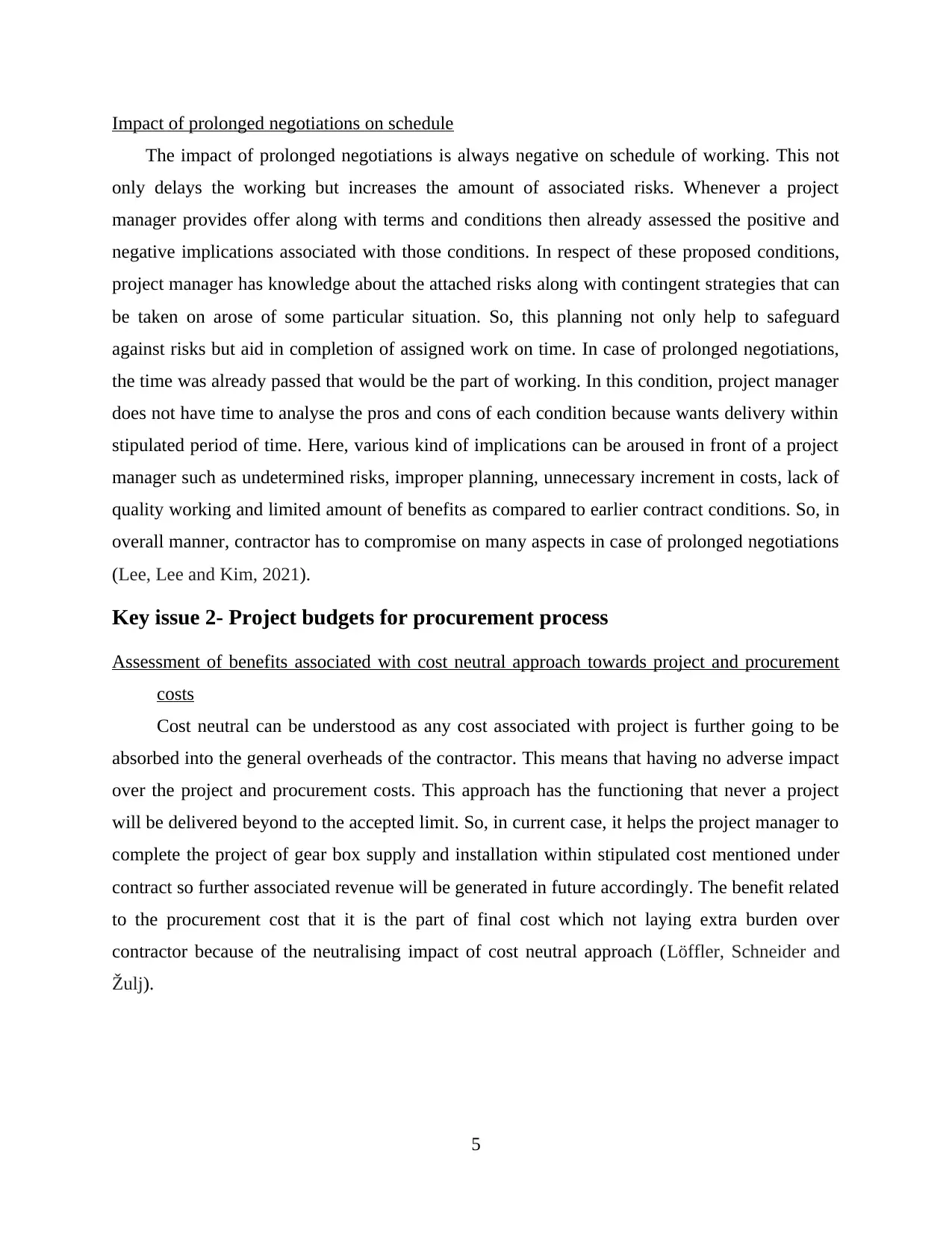
Impact of prolonged negotiations on schedule
The impact of prolonged negotiations is always negative on schedule of working. This not
only delays the working but increases the amount of associated risks. Whenever a project
manager provides offer along with terms and conditions then already assessed the positive and
negative implications associated with those conditions. In respect of these proposed conditions,
project manager has knowledge about the attached risks along with contingent strategies that can
be taken on arose of some particular situation. So, this planning not only help to safeguard
against risks but aid in completion of assigned work on time. In case of prolonged negotiations,
the time was already passed that would be the part of working. In this condition, project manager
does not have time to analyse the pros and cons of each condition because wants delivery within
stipulated period of time. Here, various kind of implications can be aroused in front of a project
manager such as undetermined risks, improper planning, unnecessary increment in costs, lack of
quality working and limited amount of benefits as compared to earlier contract conditions. So, in
overall manner, contractor has to compromise on many aspects in case of prolonged negotiations
(Lee, Lee and Kim, 2021).
Key issue 2- Project budgets for procurement process
Assessment of benefits associated with cost neutral approach towards project and procurement
costs
Cost neutral can be understood as any cost associated with project is further going to be
absorbed into the general overheads of the contractor. This means that having no adverse impact
over the project and procurement costs. This approach has the functioning that never a project
will be delivered beyond to the accepted limit. So, in current case, it helps the project manager to
complete the project of gear box supply and installation within stipulated cost mentioned under
contract so further associated revenue will be generated in future accordingly. The benefit related
to the procurement cost that it is the part of final cost which not laying extra burden over
contractor because of the neutralising impact of cost neutral approach (Löffler, Schneider and
Žulj).
5
The impact of prolonged negotiations is always negative on schedule of working. This not
only delays the working but increases the amount of associated risks. Whenever a project
manager provides offer along with terms and conditions then already assessed the positive and
negative implications associated with those conditions. In respect of these proposed conditions,
project manager has knowledge about the attached risks along with contingent strategies that can
be taken on arose of some particular situation. So, this planning not only help to safeguard
against risks but aid in completion of assigned work on time. In case of prolonged negotiations,
the time was already passed that would be the part of working. In this condition, project manager
does not have time to analyse the pros and cons of each condition because wants delivery within
stipulated period of time. Here, various kind of implications can be aroused in front of a project
manager such as undetermined risks, improper planning, unnecessary increment in costs, lack of
quality working and limited amount of benefits as compared to earlier contract conditions. So, in
overall manner, contractor has to compromise on many aspects in case of prolonged negotiations
(Lee, Lee and Kim, 2021).
Key issue 2- Project budgets for procurement process
Assessment of benefits associated with cost neutral approach towards project and procurement
costs
Cost neutral can be understood as any cost associated with project is further going to be
absorbed into the general overheads of the contractor. This means that having no adverse impact
over the project and procurement costs. This approach has the functioning that never a project
will be delivered beyond to the accepted limit. So, in current case, it helps the project manager to
complete the project of gear box supply and installation within stipulated cost mentioned under
contract so further associated revenue will be generated in future accordingly. The benefit related
to the procurement cost that it is the part of final cost which not laying extra burden over
contractor because of the neutralising impact of cost neutral approach (Löffler, Schneider and
Žulj).
5
Paraphrase This Document
Need a fresh take? Get an instant paraphrase of this document with our AI Paraphraser
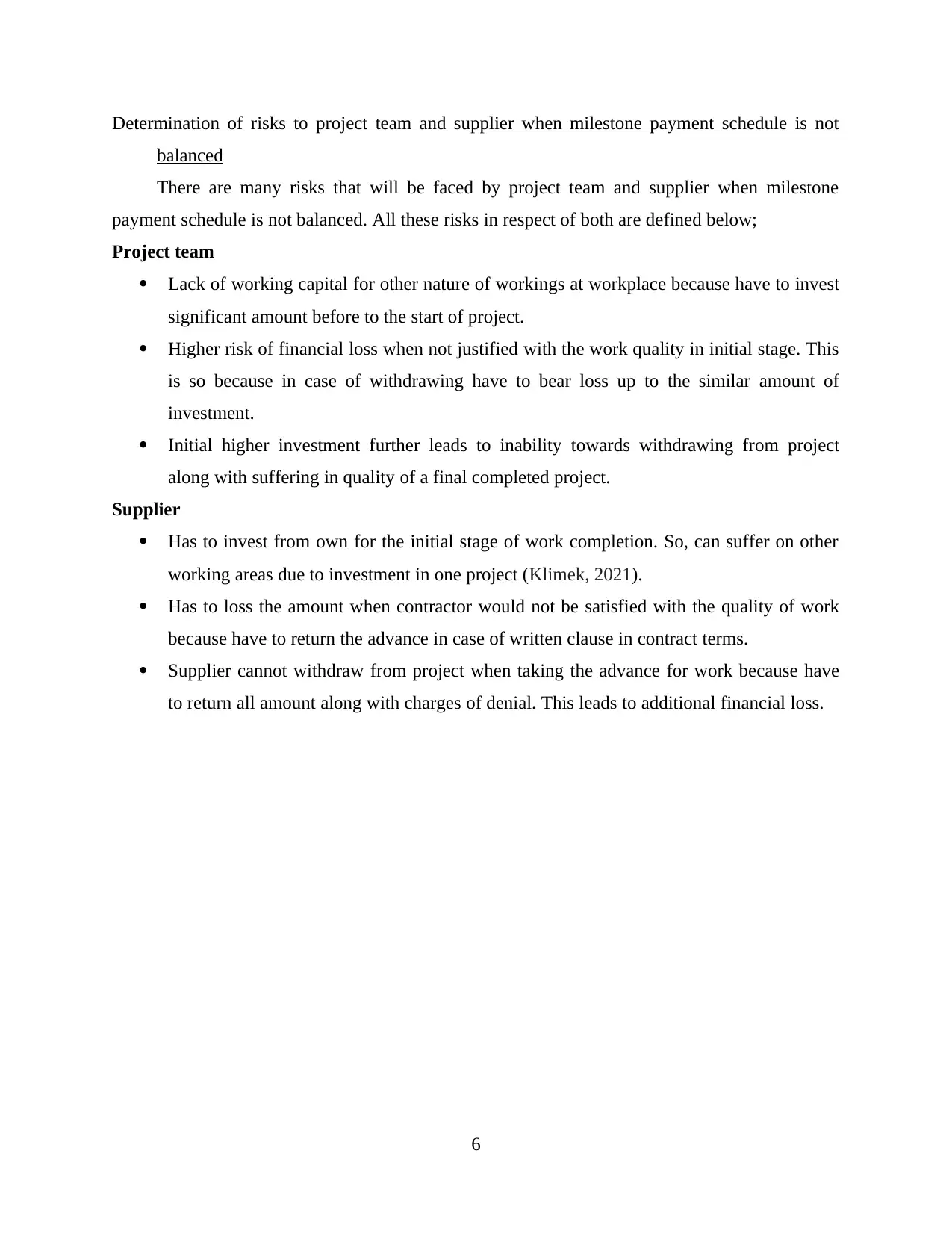
Determination of risks to project team and supplier when milestone payment schedule is not
balanced
There are many risks that will be faced by project team and supplier when milestone
payment schedule is not balanced. All these risks in respect of both are defined below;
Project team
Lack of working capital for other nature of workings at workplace because have to invest
significant amount before to the start of project.
Higher risk of financial loss when not justified with the work quality in initial stage. This
is so because in case of withdrawing have to bear loss up to the similar amount of
investment.
Initial higher investment further leads to inability towards withdrawing from project
along with suffering in quality of a final completed project.
Supplier
Has to invest from own for the initial stage of work completion. So, can suffer on other
working areas due to investment in one project (Klimek, 2021).
Has to loss the amount when contractor would not be satisfied with the quality of work
because have to return the advance in case of written clause in contract terms.
Supplier cannot withdraw from project when taking the advance for work because have
to return all amount along with charges of denial. This leads to additional financial loss.
6
balanced
There are many risks that will be faced by project team and supplier when milestone
payment schedule is not balanced. All these risks in respect of both are defined below;
Project team
Lack of working capital for other nature of workings at workplace because have to invest
significant amount before to the start of project.
Higher risk of financial loss when not justified with the work quality in initial stage. This
is so because in case of withdrawing have to bear loss up to the similar amount of
investment.
Initial higher investment further leads to inability towards withdrawing from project
along with suffering in quality of a final completed project.
Supplier
Has to invest from own for the initial stage of work completion. So, can suffer on other
working areas due to investment in one project (Klimek, 2021).
Has to loss the amount when contractor would not be satisfied with the quality of work
because have to return the advance in case of written clause in contract terms.
Supplier cannot withdraw from project when taking the advance for work because have
to return all amount along with charges of denial. This leads to additional financial loss.
6
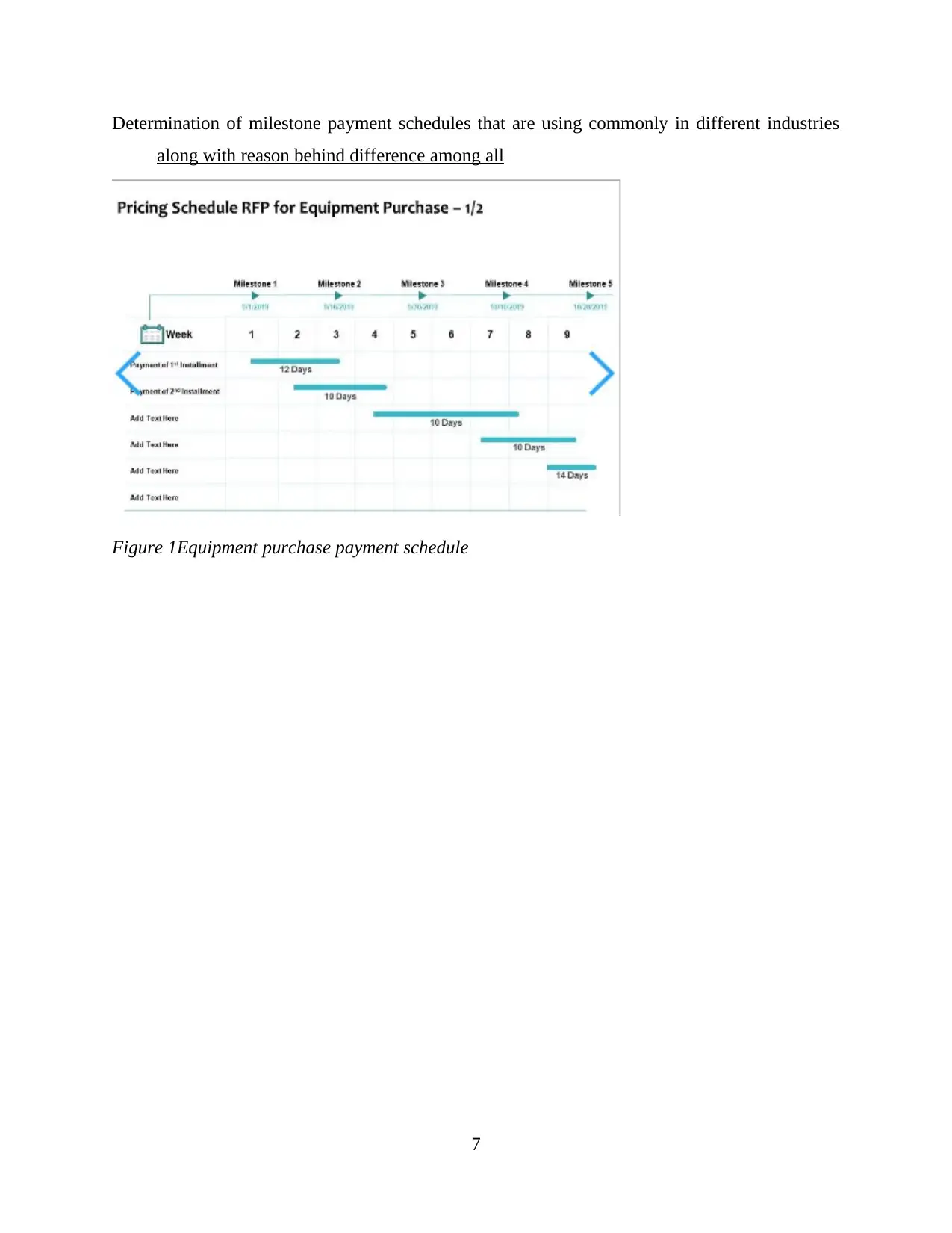
Determination of milestone payment schedules that are using commonly in different industries
along with reason behind difference among all
Figure 1Equipment purchase payment schedule
7
along with reason behind difference among all
Figure 1Equipment purchase payment schedule
7
⊘ This is a preview!⊘
Do you want full access?
Subscribe today to unlock all pages.

Trusted by 1+ million students worldwide
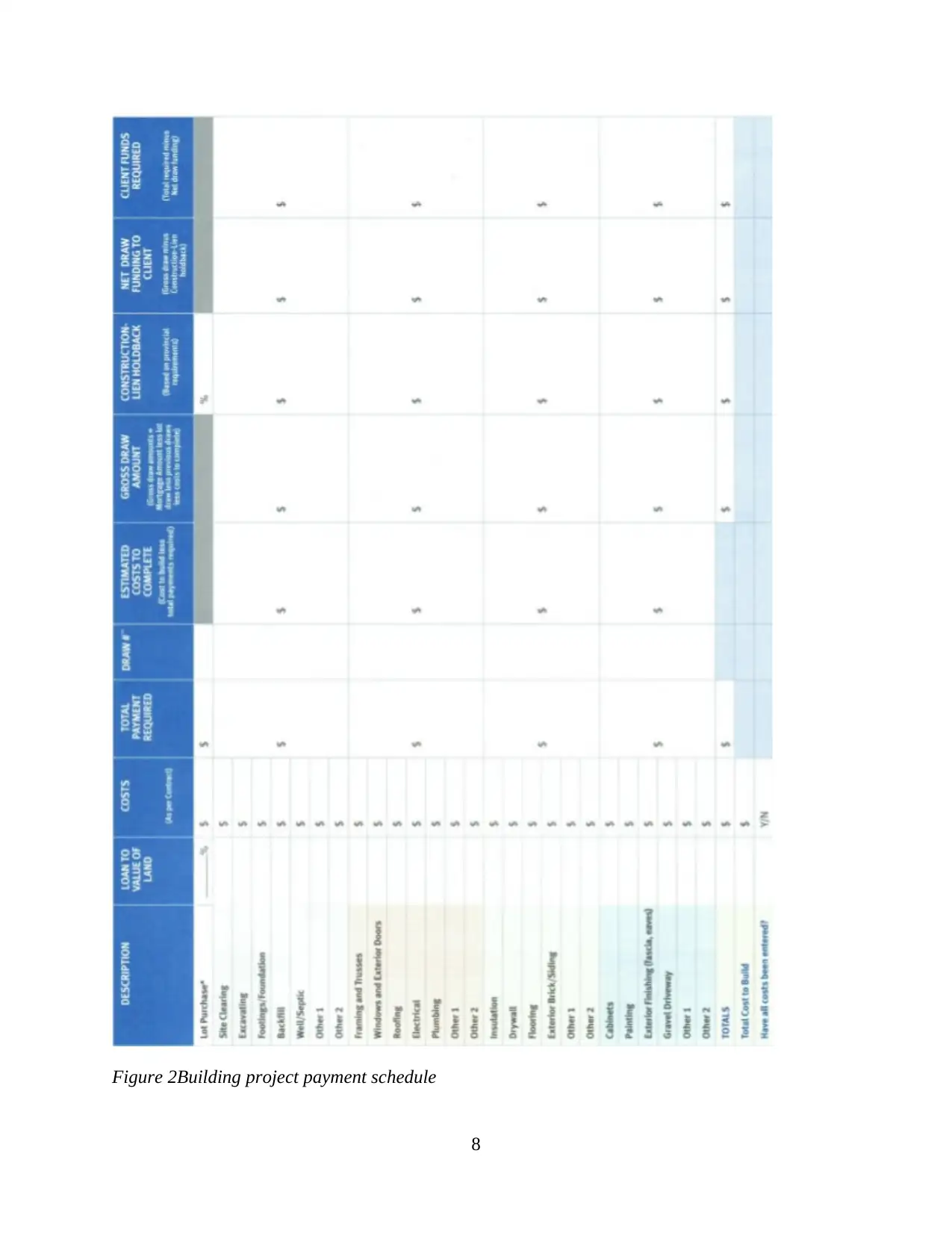
Figure 2Building project payment schedule
8
8
Paraphrase This Document
Need a fresh take? Get an instant paraphrase of this document with our AI Paraphraser
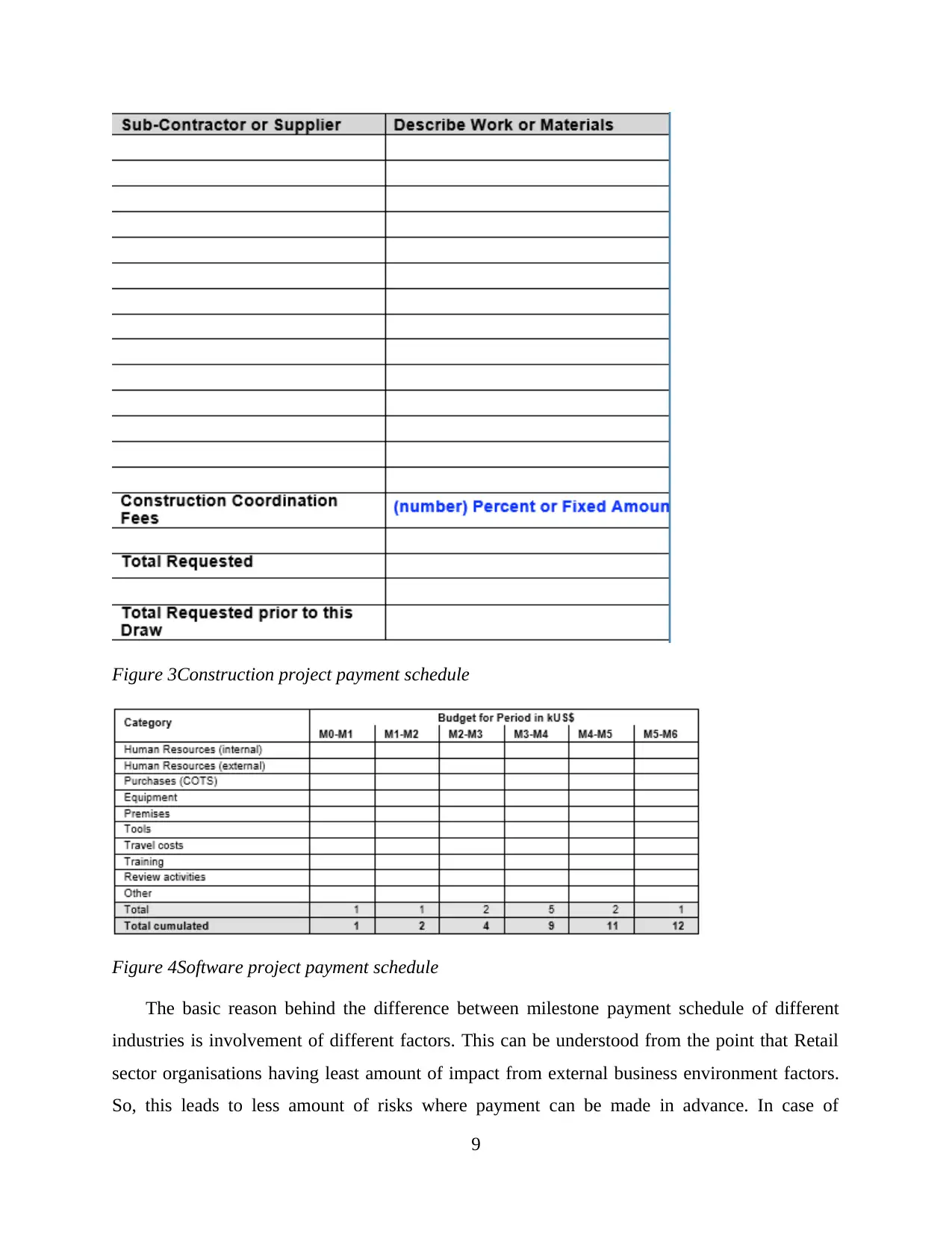
Figure 3Construction project payment schedule
Figure 4Software project payment schedule
The basic reason behind the difference between milestone payment schedule of different
industries is involvement of different factors. This can be understood from the point that Retail
sector organisations having least amount of impact from external business environment factors.
So, this leads to less amount of risks where payment can be made in advance. In case of
9
Figure 4Software project payment schedule
The basic reason behind the difference between milestone payment schedule of different
industries is involvement of different factors. This can be understood from the point that Retail
sector organisations having least amount of impact from external business environment factors.
So, this leads to less amount of risks where payment can be made in advance. In case of
9
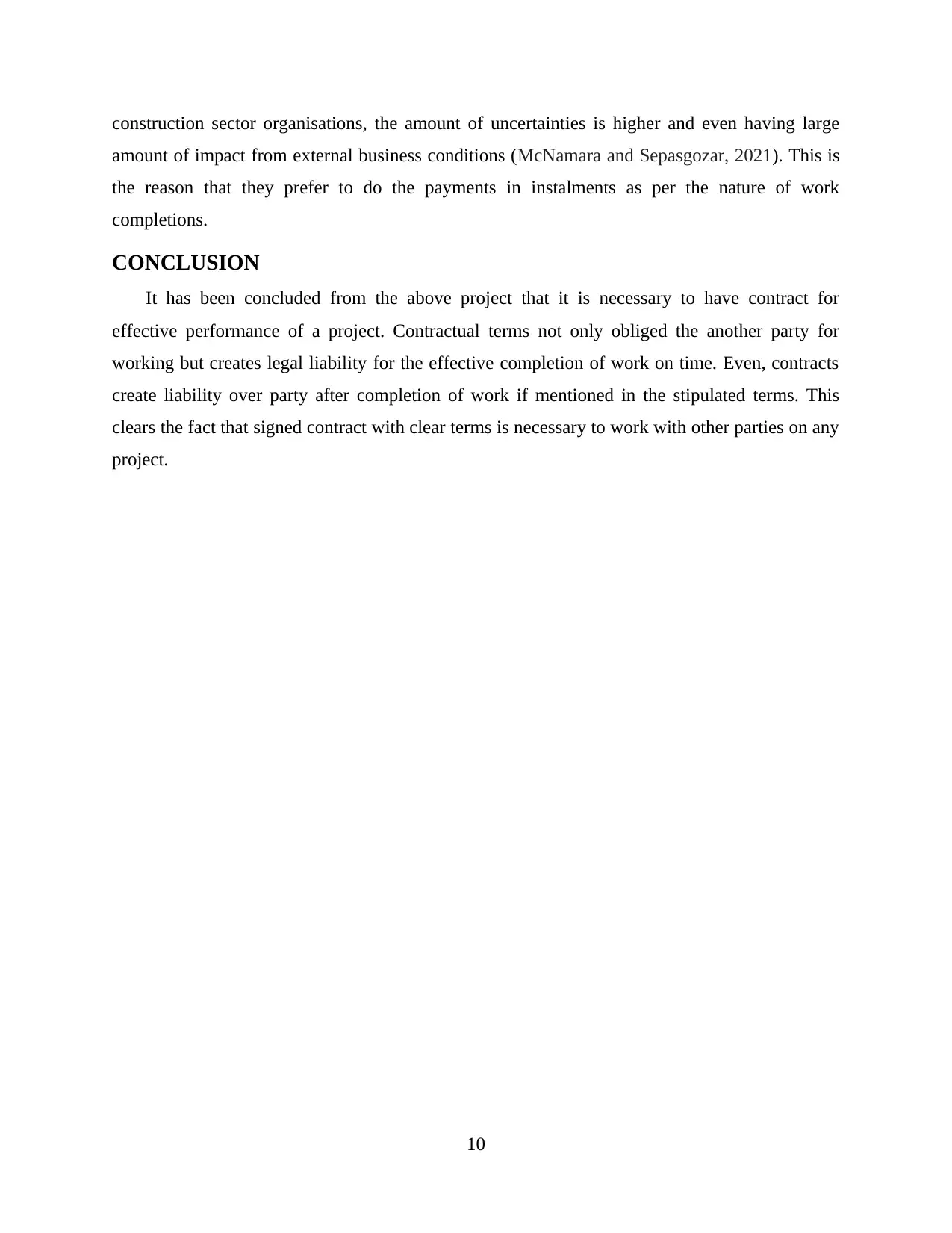
construction sector organisations, the amount of uncertainties is higher and even having large
amount of impact from external business conditions (McNamara and Sepasgozar, 2021). This is
the reason that they prefer to do the payments in instalments as per the nature of work
completions.
CONCLUSION
It has been concluded from the above project that it is necessary to have contract for
effective performance of a project. Contractual terms not only obliged the another party for
working but creates legal liability for the effective completion of work on time. Even, contracts
create liability over party after completion of work if mentioned in the stipulated terms. This
clears the fact that signed contract with clear terms is necessary to work with other parties on any
project.
10
amount of impact from external business conditions (McNamara and Sepasgozar, 2021). This is
the reason that they prefer to do the payments in instalments as per the nature of work
completions.
CONCLUSION
It has been concluded from the above project that it is necessary to have contract for
effective performance of a project. Contractual terms not only obliged the another party for
working but creates legal liability for the effective completion of work on time. Even, contracts
create liability over party after completion of work if mentioned in the stipulated terms. This
clears the fact that signed contract with clear terms is necessary to work with other parties on any
project.
10
⊘ This is a preview!⊘
Do you want full access?
Subscribe today to unlock all pages.

Trusted by 1+ million students worldwide
1 out of 13
Related Documents
Your All-in-One AI-Powered Toolkit for Academic Success.
+13062052269
info@desklib.com
Available 24*7 on WhatsApp / Email
![[object Object]](/_next/static/media/star-bottom.7253800d.svg)
Unlock your academic potential
Copyright © 2020–2025 A2Z Services. All Rights Reserved. Developed and managed by ZUCOL.





